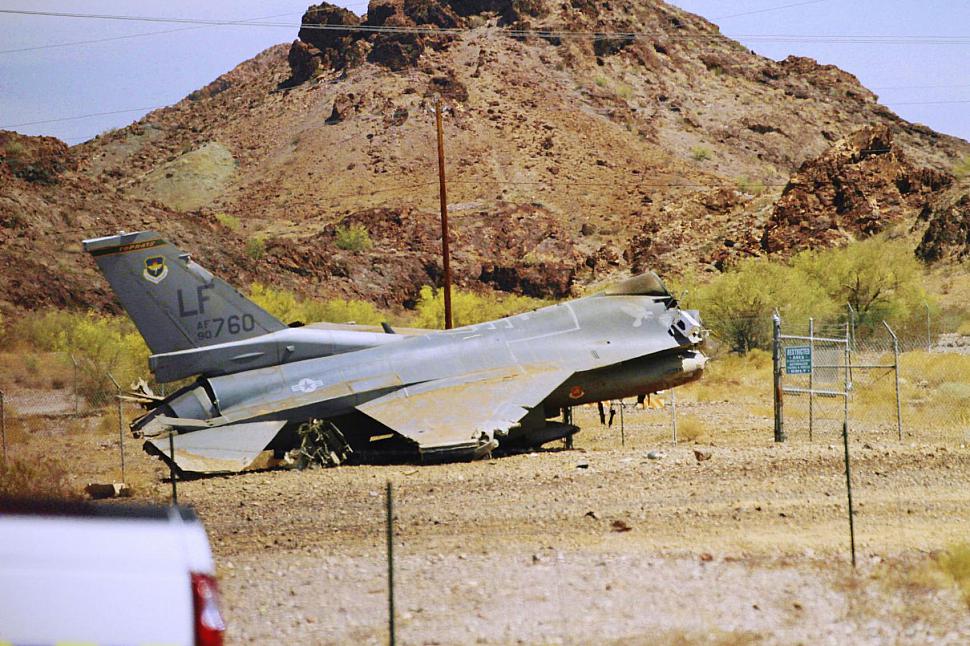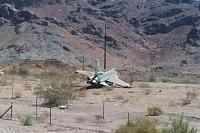Fighter Jet News
F-16 Fighting Falcon News
F-16 crashes in Western Arizona
April 24, 2018 (by
Corey Dickstein) -
The Air Force pilot who ejected from an F-16C fighter jet that crashed in Arizona Tuesday morning has been released from the hospital.
The pilot, who has not been identified, was taken to Havasu Regional Medical Center and released Tuesday afternoon, Air Force officials said in a statement.
He ejected while attempting to land at a small municipal airport in western Arizona along the state’s border with California.
Personnel from Luke Air Force Base, where the jet was assigned, were en route to the scene to begin recovery of the aircraft, the Air Force said. Flight operations at Luke resumed in the afternoon after a hiatus of several hours.
The Fighting Falcon was diverted to Lake Havasu City Municipal Airport at about 10:35 a.m. local time during a routine training flight, according to a statement from Luke. The jet was unable to remain on the runway as it landed, forcing the pilot to eject, according to the statement.
An interim safety investigation board has been established for the incident and will conduct a full investigation, the Air Force said.
The Air Force declined to explain why the jet was diverted, but the incident was described as an “emergency landing” by Lake Havasu Fire Department officials in a statement posted on the department’s Facebook page. The statement said fire, police and other emergency responders were at the site.
The F-16 was assigned to Luke’s 56th Fighter Wing, which trains pilots on the F-16 and F-35A Lightning II. The base — home to nearly 80 F-16s and nearly 70 F-35As — graduates nearly 300 pilots each year, according to figures provided by Luke’s public affairs office.
The crash Tuesday was at least the second involving an Air Force F-16 this month. Air Force Maj. Stephen Del Bagno, a new member of the service’s elite Thunderbirds demonstration squadron, was killed April 4 when his F-16 crashed during training on a military range near Nellis Air Force Base outside Las Vegas.
Earlier this month, Gen. David Goldfein, the Air Force chief of staff, ordered the Safety Office at Headquarters Air Force to review Class C mishaps in an effort to drive down a recent uptick in their occurrences, Air Force officials said. Class C mishaps are defined as resulting in damages costing $50,000 or more but less than $500,000 in repairs or a nonfatal injury that results in more than one day away from work.
More serious Class B and Class A mishaps, which include damages of more than $2 million to an aircraft, a fatality or a permanent disability, have occurred less frequently in recent years, according to the Air Force.
He ejected while attempting to land at a small municipal airport in western Arizona along the state’s border with California.
Personnel from Luke Air Force Base, where the jet was assigned, were en route to the scene to begin recovery of the aircraft, the Air Force said. Flight operations at Luke resumed in the afternoon after a hiatus of several hours.
The Fighting Falcon was diverted to Lake Havasu City Municipal Airport at about 10:35 a.m. local time during a routine training flight, according to a statement from Luke. The jet was unable to remain on the runway as it landed, forcing the pilot to eject, according to the statement.
An interim safety investigation board has been established for the incident and will conduct a full investigation, the Air Force said.
The Air Force declined to explain why the jet was diverted, but the incident was described as an “emergency landing” by Lake Havasu Fire Department officials in a statement posted on the department’s Facebook page. The statement said fire, police and other emergency responders were at the site.
The F-16 was assigned to Luke’s 56th Fighter Wing, which trains pilots on the F-16 and F-35A Lightning II. The base — home to nearly 80 F-16s and nearly 70 F-35As — graduates nearly 300 pilots each year, according to figures provided by Luke’s public affairs office.
The crash Tuesday was at least the second involving an Air Force F-16 this month. Air Force Maj. Stephen Del Bagno, a new member of the service’s elite Thunderbirds demonstration squadron, was killed April 4 when his F-16 crashed during training on a military range near Nellis Air Force Base outside Las Vegas.
Earlier this month, Gen. David Goldfein, the Air Force chief of staff, ordered the Safety Office at Headquarters Air Force to review Class C mishaps in an effort to drive down a recent uptick in their occurrences, Air Force officials said. Class C mishaps are defined as resulting in damages costing $50,000 or more but less than $500,000 in repairs or a nonfatal injury that results in more than one day away from work.
More serious Class B and Class A mishaps, which include damages of more than $2 million to an aircraft, a fatality or a permanent disability, have occurred less frequently in recent years, according to the Air Force.
Published on April 24th, 2018 in the Stars and Stripes.
Used with permission from Stars and Stripes, a DoD publication.
© 2018 Stars and Stripes.
Additional images:
Related articles:
Forum discussion:
Tags
- Iraqi student pilot killed in F-16D crashed in Arizona (2017-09-05)
- Pilot ejects from burning F-16C at Houston Airport (2017-06-21)
- Thunderbird F-16 goes down near Colorado springs (2016-06-02)
- Luke F-16 crashes near Bagdad Arizona, Taiwanese pilot killed (2016-01-21)
- F-16 Fighting Falcon news archive
Forum discussion:
- Luke Viper down in AZ ( 6 replies)
Tags


